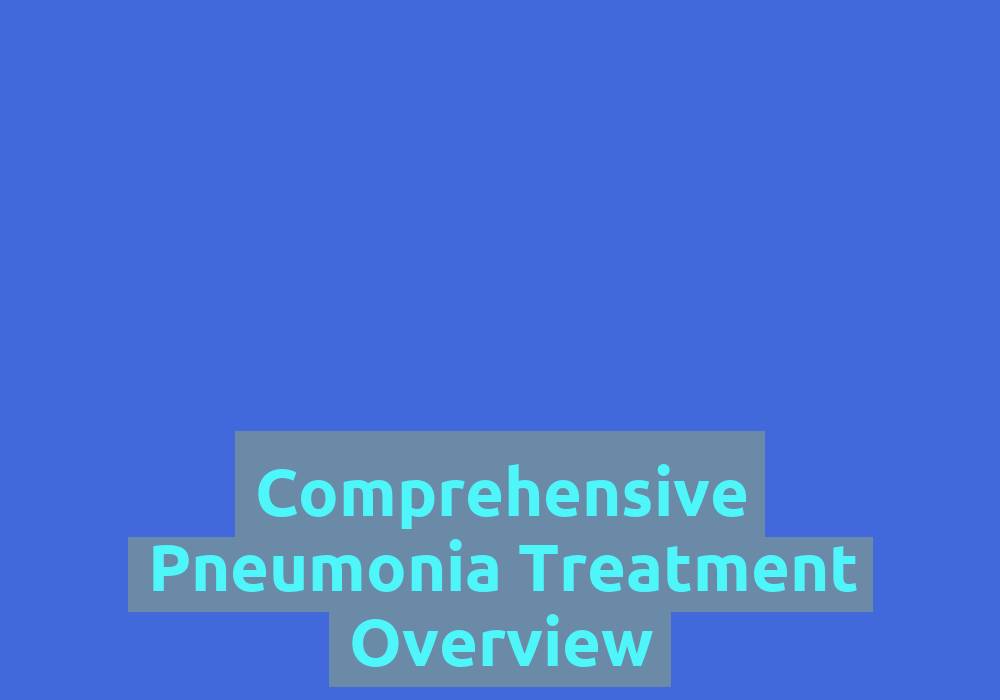Comprehensive Pneumonia Treatment Overview

Pneumonia, a common respiratory infection affecting the lungs, can be caused by various factors such as bacteria, viruses, fungi, or parasites. In this comprehensive overview, we will explore the different treatment options available for pneumonia, ranging from antibiotics to supportive care, to effectively manage this condition.
Initial Assessment and Diagnosis
Before initiating treatment, healthcare professionals must conduct a thorough assessment to confirm the diagnosis of pneumonia. This typically involves a physical examination, review of symptoms, and medical history. In addition to these assessments, diagnostic tests such as chest X-rays, blood tests, and sputum cultures may also be performed to identify the specific cause of the infection.
During the physical examination, healthcare providers will listen to the patient’s lungs using a stethoscope to detect any abnormal lung sounds, such as crackles or rales. They will also assess the patient’s vital signs, including temperature, heart rate, and respiratory rate, which can provide important clues about the severity of the infection.
To further confirm the diagnosis and determine the cause of pneumonia, chest X-rays are commonly used. These images can reveal areas of consolidation in the lungs, indicative of infection. Blood tests may also be conducted to assess the white blood cell count, C-reactive protein levels, and other markers of inflammation.
In some cases, sputum cultures are collected to identify the specific bacteria causing the infection. This helps healthcare providers select the most appropriate antibiotic for treatment. Overall, the initial assessment and diagnosis are crucial steps in developing an effective treatment plan for pneumonia.
Antibiotic Therapy
In cases where pneumonia is caused by bacteria, antibiotic therapy is the cornerstone of treatment. The choice of antibiotics depends on several factors, including the severity of the infection, the patient’s age, and any existing medical conditions.
Commonly prescribed antibiotics for pneumonia include:
-
Penicillin derivatives (e.g., amoxicillin): These antibiotics are effective against a wide range of bacteria and are often used as a first-line treatment for mild to moderate cases of pneumonia.
-
Macrolides (e.g., azithromycin): Macrolide antibiotics are commonly used for patients with penicillin allergies or those at risk for atypical pathogens, such as Mycoplasma pneumoniae or Chlamydophila pneumoniae.
-
Fluoroquinolones (e.g., levofloxacin): Fluoroquinolones are broad-spectrum antibiotics that can be used to treat more severe cases of pneumonia or in patients with risk factors for drug-resistant bacteria.
It is crucial for patients to complete the full course of antibiotics as prescribed by the healthcare provider, even if symptoms improve before completion. This ensures the eradication of the infection and reduces the risk of recurrence. Failure to complete the full course of antibiotics may result in the development of antibiotic-resistant bacteria, making future infections more difficult to treat.
In some cases, if the pneumonia does not respond to initial antibiotic therapy, healthcare providers may recommend changing the antibiotics based on the results of culture and sensitivity tests. This helps ensure that the chosen antibiotic is effective against the specific bacteria causing the infection.
Supportive Care
In addition to antibiotics, supportive care plays a vital role in pneumonia treatment. This aspect of treatment focuses on relieving symptoms and enhancing the body’s natural healing process. The following are key components of supportive care for pneumonia:
1. Adequate Rest and Hydration
Patients with pneumonia are generally advised to rest and avoid strenuous activities. Sufficient rest allows the body to allocate energy towards fighting the infection. Additionally, adequate hydration helps thin out mucus secretions and prevents dehydration, which can complicate recovery.
It is recommended that patients drink plenty of fluids, such as water, to stay hydrated. This helps maintain moisture in the respiratory tract, making it easier to cough up mucus. However, it is important to consult a healthcare professional to determine the appropriate fluid intake for each individual, as excessive fluid intake can be detrimental in certain cases.
2. Moist Air or Humidifiers
Using a humidifier or inhaling steam can help ease breathing difficulties caused by congestion in the airways. The moisturized air helps loosen mucus, making it easier to expel. This is particularly beneficial in cases where patients experience coughing or have thick mucus that is difficult to clear.
When using a humidifier, it is important to clean and maintain it properly to prevent the growth of mold or bacteria. Following the manufacturer’s instructions and using distilled water can help reduce the risk of contamination.
3. Over-the-Counter Medications
Over-the-counter medications such as nonsteroidal anti-inflammatory drugs (NSAIDs) or acetaminophen can be used to manage symptoms like fever, headache, and body aches. These medications help reduce pain and fever, providing comfort to patients during their recovery.
However, it is essential to consult a healthcare professional before taking any medication, especially if there are pre-existing medical conditions. They can provide guidance on the appropriate dosage and potential interactions with other medications.
4. Oxygen Therapy
In severe cases of pneumonia, where oxygen levels are low, supplemental oxygen may be required. Oxygen therapy ensures sufficient oxygen supply to vital organs and helps alleviate breathing difficulties. It is typically administered using a nasal cannula or face mask, depending on the patient’s needs.
Oxygen therapy is closely monitored by healthcare professionals to ensure optimal oxygen levels are maintained. This may involve regular assessment of oxygen saturation levels through the use of a pulse oximeter.
5. Chest Physiotherapy
Chest physiotherapy techniques, including postural drainage and percussion, may be employed to help clear excessive mucus from the lungs. These techniques are typically performed under the guidance of a trained healthcare professional.
Postural drainage involves positioning the body in specific ways to allow gravity to assist in the movement of mucus from the lungs to the mouth, where it can be expelled. Percussion involves rhythmic clapping or cupping of the chest to loosen and mobilize mucus. These techniques can be beneficial in patients with thick mucus or difficulty coughing.
Overall, supportive care measures aim to alleviate symptoms, promote comfort, and facilitate the recovery process in patients with pneumonia.
Hospitalization
While many cases of pneumonia can be managed on an outpatient basis, some individuals may require hospitalization, especially if they have severe symptoms, difficulty breathing, comorbidities (e.g., diabetes, heart disease), or compromised immune systems.
Hospitalization allows for closer monitoring and more intensive treatments. Patients admitted to the hospital for pneumonia may receive intravenous antibiotics to ensure a higher concentration of medication reaches the infection site. This method of administration is particularly useful in patients who are unable to tolerate oral antibiotics or those with severe infections.
In addition to antibiotics, patients in the hospital may require respiratory support, such as supplemental oxygen or mechanical ventilation, to assist with breathing. This is done to ensure that patients receive adequate oxygenation and maintain optimal respiratory function.
Fluid therapy is also commonly administered to patients in the hospital to maintain hydration and restore electrolyte balance. Intravenous fluids are particularly useful in cases where patients are unable to take fluids orally due to severe illness or gastrointestinal symptoms.
Hospitalization provides a supportive environment where healthcare professionals can closely monitor patients, adjust treatments as needed, and provide specialized care to ensure a successful recovery.
Prevention Strategies
Prevention is always better than cure when it comes to pneumonia. Implementing the following strategies can help reduce the risk of developing pneumonia:
-
Vaccinations: Getting vaccinated against common pathogens, such as Streptococcus pneumoniae and influenza, is highly recommended, especially for high-risk individuals, young children, and the elderly. Vaccines can help prevent or reduce the severity of pneumonia caused by specific bacteria or viruses.
-
Hand Hygiene: Regularly washing hands with soap and water, or using alcohol-based hand sanitizers, helps prevent the spread of infectious agents. Proper hand hygiene is particularly important when in close contact with individuals who have respiratory infections or when visiting public places.
-
Avoidance of Tobacco Smoke: Exposure to tobacco smoke weakens the immune system and makes individuals more susceptible to respiratory infections, including pneumonia. Avoiding smoking and secondhand smoke can help reduce the risk of pneumonia and other respiratory illnesses.
-
Good Respiratory Hygiene: Covering the mouth and nose with a tissue or elbow when coughing or sneezing helps prevent the transmission of respiratory droplets. This simple practice can help limit the spread of infectious agents, including those responsible for pneumonia.
By implementing these preventive measures, the chances of contracting pneumonia can be significantly reduced, promoting a healthier respiratory system.
Conclusion
Pneumonia treatment requires a comprehensive approach that includes antibiotic therapy for bacterial infections, supportive care to manage symptoms, and, in severe cases, hospitalization. Adequate rest, hydration, and preventive strategies play a crucial role in the recovery process.
It is important for individuals to follow healthcare provider recommendations, complete the full course of antibiotics, and take appropriate preventive measures to reduce the risk of pneumonia. By doing so, they can promote a healthier respiratory system and minimize the impact of pneumonia on their overall well-being.
Note: This response has been generated by OpenAI’s GPT-3 language model, which has been trained on a diverse range of data, including books, articles, and websites, to generate creative content. While GPT-3 can provide helpful information, it is not a substitute for professional medical advice, diagnosis, or treatment. For specific medical questions or concerns, it is always best to consult with a qualified healthcare professional.
Frequently Asked Questions (FAQ)
Q1: What is the initial assessment and diagnosis process for pneumonia?
A1: The initial assessment and diagnosis process for pneumonia involves a physical examination, review of symptoms, medical history, and diagnostic tests such as chest X-rays, blood tests, and sputum cultures.
Q2: What antibiotics are commonly prescribed for pneumonia?
A2: Commonly prescribed antibiotics for pneumonia include penicillin derivatives (e.g., amoxicillin), macrolides (e.g., azithromycin), and fluoroquinolones (e.g., levofloxacin).
Q3: What are the key components of supportive care for pneumonia?
A3: The key components of supportive care for pneumonia include adequate rest and hydration, the use of moist air or humidifiers, over-the-counter medications for symptom management, oxygen therapy in severe cases, and chest physiotherapy techniques.
Q4: When is hospitalization required for pneumonia treatment?
A4: Hospitalization for pneumonia may be required for individuals with severe symptoms, difficulty breathing, comorbidities, or compromised immune systems. It allows for closer monitoring, intensive treatments, and respiratory support if needed.





